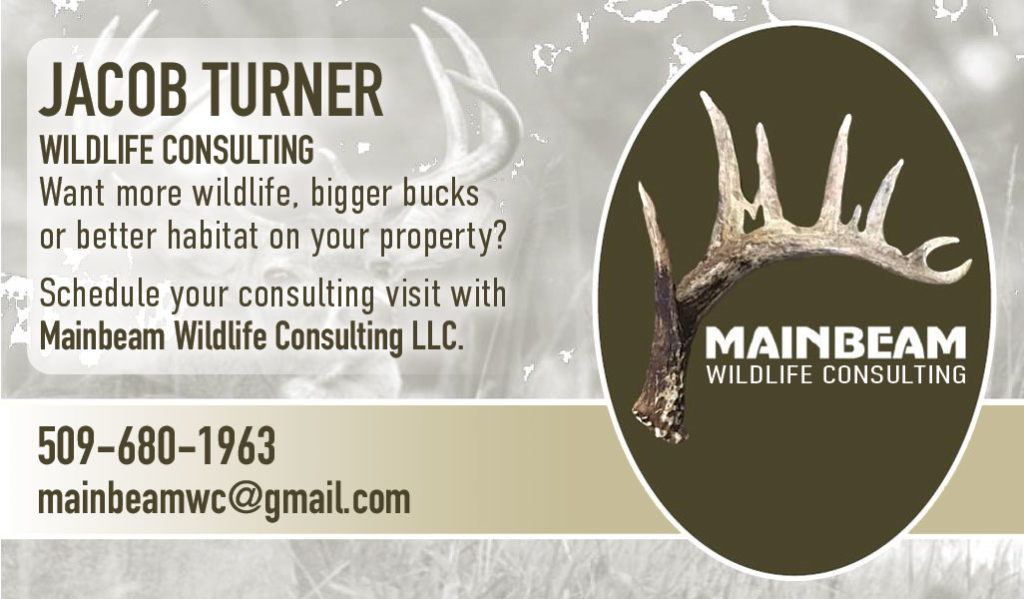by Jacob Turner
If seeing and killing more deer this fall interests you, April is the time to start developing food plots and the habitat necessary to get those deer interested in your property. As a private wildlife consultant, it is my job to help you assess your properties strengths and weaknesses and figure out how to maximize the attractiveness of your property. Let’s cut to the chase so you know if this article is for you or not. This is not another article on how you need more food plots or bigger food plots and that’s the ONLY way you will shoot the “big one”. Instead this article is about the importance of the “Big Four” key essentials to wildlife habitat and finding the right combination on your land to benefit the most wildlife. So, grab your cup of coffee and let’s dive in.

In big game wildlife management, there are 4 key essentials needed in every habitat. Food and water are both no brainers that everybody (whether your wildlife savvy or not) will likely be able to respond with when asked. Both for obvious reasons as they are essential for life. The other two key essentials require a little more thought and reasoning as to why they are considered essential parts of big game habitat. Cover and open space are the final two pieces to the “essential for quality big game habitat” puzzle.
When talking about cover, we aren’t just talking about overhead canopy cover. Cover, when it comes to wildlife can be anything from a stand of tall bunch grasses, to shrubs, hardwoods, and coniferous forests. Anything that can provide concealment will suffice for cover for most wildlife. The biggest benefit to cover is not necessarily for thermal regulation as many have thought for years. Instead it is the importance of being hidden, mostly from predators and hunters. Thermal regulation is a small part of cover when it comes to escaping the heat of summer, or the dead cold of winter when bedding under an old pine where little snow has accumulated. The last reason that I will mention, and possibly most important reason cover is vital to survival is for hiding and protecting calves and fawns in the spring. Having that tall grass, the small bunch of shrubs, or any other types of cover suitable for stashing babies is critical for herd survival on and around your property.
You may be asking “why is open space so essential?” This thought has been a more recent addition to the first three most important aspects of big game habitat. There are many important reasons to add open space to the “Big Four” key essentials list. Open space is where most grazing and food consumption occurs. Where the light is reaching the forest floor, or where the ag fields open for the nightly buffet, or maybe the new clear-cut where the fresh browse is coming in strong. Open space is also important for visual safety to detect predators or other dangers approaching. Open space is used by most big game species during the rut when multiple bucks or bulls may be trying to gather cows or does and fend off the hopeful bystanders.
Now that we have discussed the “Big Four” essentials in wildlife habitat management, I want to point out one of the most over looked aspects of keeping deer on/near your property year-round. That being fall and winter food sources. Fall is a critical time of the year for deer when it comes to diet and preparing their bodies for winter time and limited sources of vegetation. Coming off the rut, most bucks/bulls are short of fat storage and are trying to stock back up in November and December to make it through the harsh winter months until things start to green back up. There are many ways to help get through these tough months…

Fruit trees, food plots, and fresh cuttings can be thought of the “Three F’s” if you like to think in acronyms like me. There are many varieties and species of fruit trees that can produce viable fruit from as early as August through as late as early December in our part of the country. Food plots can be used to provide the missing ingredients in your “wildlife food pantry”. There are many winter hardy plants that can be planted specifically to be viable and beneficial in those harsh winter months. And lastly, fresh cuttings are a food option that give big game access to buds, leaves, moss and other sources of food that otherwise they may not have been able to reach had they not been trimmed or cut down.
As a wildlife consultant, my goal is to help you as a landowner assess the “Big Four” on your property and figure out ways we can create the optimal habitat for your wildlife. Call Mainbeam Wildlife Consulting LLC and see how we can help you maximize the potential on your land and create the best habitat possible.

